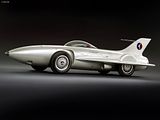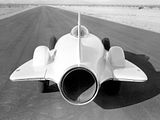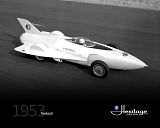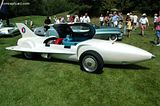The General Motors Firebird is a trilogy of three prototype cars designed by Harley Earl, and engineered by General Motors for the 1953, 1956 and 1959 Motorama auto shows. They were very much inspired by innovations in fighter aircraft design at the time. None of the designs were intended for production, but instead were to showcase the extremes in technology and design that General Motors was able to achieve. The cars were recently placed on display at the Henry Ford Museum in Dearborn, Michigan, and still make regular car show appearances. General Motors had done research on feasibility of gas turbine engines in cars as early as the 1930s. It wasn't until the early 1950s that they began building an actual engine, with Emmett Conklin leading the project. The top speed of all 4 of them are 200 MPH. By 1953, the research team had produced the Firebird XP-21, later referred to as the Firebird I, which was essentially a jet airplane on wheels. It was the first gas turbine powered car tested in the United States. The design is entirely impractical, with a bubble topped canopy over a single seat cockpit, a bullet shaped fuselage made entirely of fiberglass, short wings, and a vertical tail fin. It has a 370 hp (280 kW) Whirlfire Turbo Power gas turbine engine, which has two speeds, and expels jet exhaust at some 1,250 °F (677 °C). The entire weight of the car is 2,500 lb (1,134 kg) and had a 100 inch wheelbase. The 1953 XP-21 Firebird 1 was the first gas turbine automobile ever to be built and tested in the United States. Designed strictly as an engineering and styling exercise, Firebird 1 was intended to determine whether the gas turbine could be used as an efficient and economical powerplant for future vehicles. The idea for Firebird 1 originated with Harley J. Earl, the legendary GM Styling Vice President, who also designed the car's aircraft-inspired fiberglass-reinforced plastic body. The engine, termed "Whirlfire Turbo-Power," was developed under the direction of Charles L. McCuen, then general manager of GM Research Laboratories Division. Unlike a jet airplane, which develops thrust through the action of exhaust gas through a tailcone, the Whirlfire Turbo-Power engine propelled the Firebird 1 through a power turbine acting on the rear wheels via a transmission. The engine was capable of 370 hp at a power turbine speed of 13,000 rpm |
|







